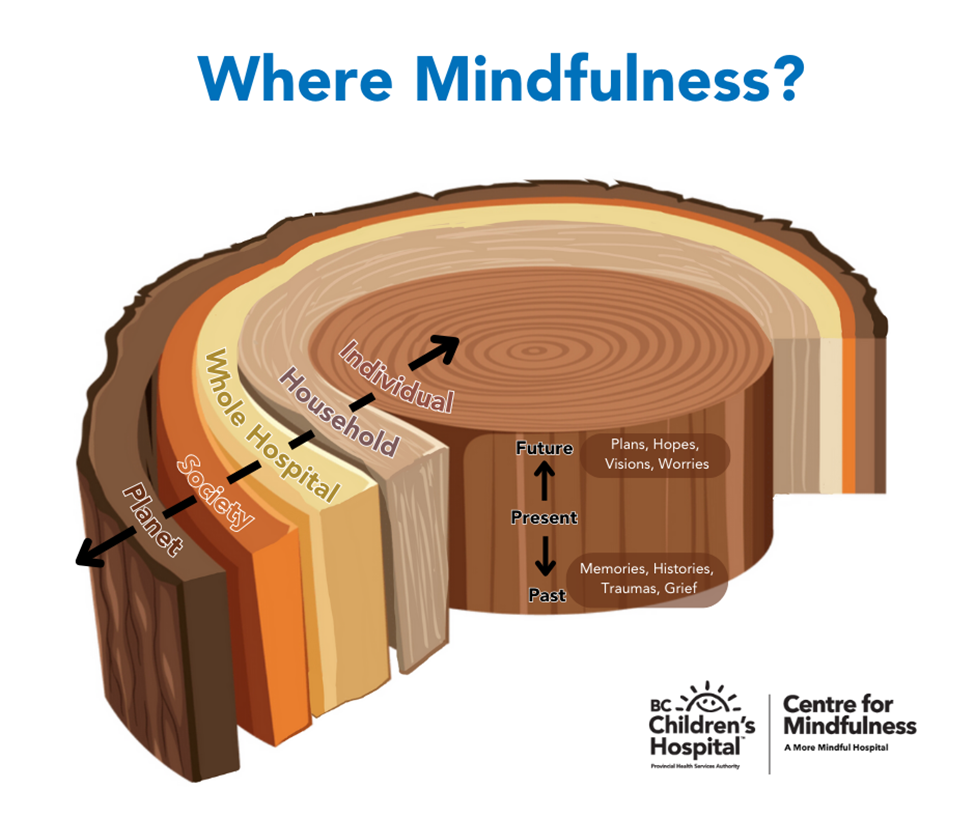We recently explored the question, WHY Mindfulness? We observed that people often are drawn to mindfulness because of suffering that they experience. In our work cultivating “a more mindful hospital,” we have seen that people may enter the path of mindfulness from the “heart” (relationships, intrapersonal and interpersonal mindfulness), the “hands” (seeking practical tools to address a difficulty), and/or the “head” (intellectual or scientific curiosity).
Now, we would like to explore the question, WHERE mindfulness? Where is mindfulness relevant or useful in our “more mindful hospital” vision?

The short answer is, Mindfulness can be valuable wherever there is suffering, which is everywhere. There are layers to the “where” question, and we can imagine these layers like growth rings of a tree. All of these layers are deeply inter-related, which is represented by the arrows connecting the layers. The arrows go in both directions: When the individual is more mindful, the household is more mindful, and vice versa. This is the essence of interpersonal mindfulness.
At the Centre of the tree is the individual. Mindfulness starts with oneself. Breathing deeply and looking inwards is a practice of growing self-awareness. Meeting our own joy and pain and strengths and weaknesses with presence and love is the practice of mindful self compassion. Zen Master Thich Nhat Hanh wrote, “Self-love is the foundation for your capacity to love the other person.” When we have a strong foundation of mindfulness within ourselves, we can share the fruits of our mindfulness practice with others, and everyone will benefit.
The second layer around the individual is the household. You may wish to substitute the words “family,” “circle of friends,” or “loved ones,” if that is more appropriate for your situation. Mindfulness is not an individual affair. Our own compassion and healing are very much inter-dependent with the compassion and healing of the people we are closest to. Zen Master Thich Nhat Hanh wrote, “In a family, if there is one person who practices mindfulness, the entire family will be more mindful. Because of the presence of one member who lives in mindfulness, the entire family is reminded to live in mindfulness.” The mindfulness of one person supports the mindfulness of the whole family, and the mindfulness of the family supports the individual. This is why our Centre aspires to offer resources and programming for parents and caregivers, who are so vital in the healing journeys of our young patients.
The third layer is the whole hospital. This is the focus of the BC Children’s Hospital Centre for Mindfulness, and our vision to cultivate a “more mindful hospital.” We believe that mindfulness and compassion are vital for all areas of our hospital. Mindfulness does not “belong” to any one area or discipline, such as mental health, or pediatrics. Our greatest aspiration is for mindfulness and compassion practices to be embedded everywhere in the hospital where there is suffering – which is, everywhere in the hospital. We envision more mindfulness opportunities for children and youth, parents and caregivers, and health professionals. Our greatest hope would be that mindfulness is embedded in the culture and is “part of the air,” in pediatric wards, mental health clinics, operating rooms, emergency departments, research labs, classrooms, cafeterias and breakrooms, gardens and walkways, our physical and digital environments, and more!
The fourth layer is society. We believe that a more mindful hospital can have a transformative power which can ripple into our city, province, country, and beyond. Our society is sorely in need of peace and healing. Engagement and action in the world, when coupled with a deep foundation in mindfulness and compassion, can be transformative, awakening the best in people, and bringing about positive change, as leaders such as Dr. Martin Luther King Jr. and Thich Nhat Hanh have shown us.
The fifth layer is the planet. Mindfulness is a natural ally to the emerging field of planetary health. Mindfulness can help us to bear witness and cope with distress related to the climate change we are witnessing and experiencing. This is especially true for young people. Mindfulness practice can help us deepen our awareness and love for our planet, as Zen Master Thich Nhat Hanh says, “fall back in love with Mother Earth.” This love can give us the energy and wisdom needed to become deeply aware of what is happening to the planet, and to channel this awareness into helpful action.
Finally, mindfulness is about time: The present, past, and future. These are represented by the vertical arrows in the tree trunk image. Mindfulness practice invites us to become deeply aware of the present moment, which is the only moment we have available to us. This does not mean, however, that we ignore the past or the future. On the contrary, mindfulness helps us to care for both the past and the future, by touching the present moment more deeply. When we are mindful, we can be more present to heal trauma (both individual and collective) that has its roots in the past and is showing up in the present moment. Similarly, when we recognize that the future is made up of the present, we care for what is in front of us right here and now, knowing that our loving action in the present moment is what is most needed for a future to be possible.
